Tracker
Types
S-2A/S2F-1
The first production version wasn't much
different from the prototype. The engine power was increased from 1500 hp
to 1525 hp. The S2F-1 had an AN/APS38 search radar in the fuselage that
could be lowered during ASW missions and a MAD boom in the tail area that
could be extended 9 feet. On the fuselage, over the cockpit a APA69 ECM
antenna was installed. This was later replaced by an AN/APA69 antenna in a
radome. The fuel tanks could contain 520 gallons of av gas, enough for a
combat range of 841 sea miles or a 6 hours flight. The cruising speed was
130 knots and the top speed was 230 knots. Under the right wing a very
powerful search light was installed for night missions. Later version
received an even more powerful light. The Tracker could carry three
underwing station for 5 inch HVAR rockets, Mk54 depth charges or 2,75 inch
rocket pods on each side. In the internal bay the S-2 could carry a Mk34
or Mk43 torpedo. In the end of both engine nacelles tubes were installed
for 8 SSQ2 and 2 SSQ1 sonobuoys. A total of 755 S-2F-1s were built.
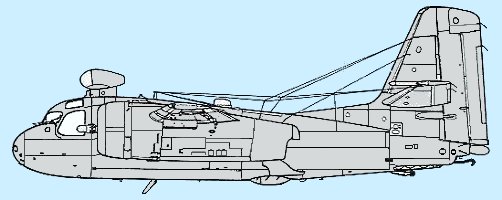
Specifications S-2A
| Length |
42 feet |
|
| Maximum speed |
265 mph |
| Wingspan |
68 feet 8 inches |
|
| Range |
841 miles |
| Height |
16 feet 3 inches |
|
| Service ceiling |
22,000 feet |
| Weight, empty |
18,315 pounds |
|
| Crew |
4 |
| Weight, maximum |
26,000 pounds
|
US-2A
51 S-2As were converted to US-2A transport aircraft and
target tug. All ASW equipment was removed, including the search light.
These aircraft could be recognized by the absence of the sonobuoy
installations in the engine nacelles. The US-2A was flown by both US Navy
and Marines Corps.
US-2B
This variant was almost identical to the US-2A, but
could carry five passengers, and cargo in the weapons bay. A total of 75
S-2As were converted to US-2B.
TS-2A/S2F-1T
Grumman built 200 S2F-Ts for and
multi-engine and ASW training. The Trackers used for multi-engine training
lacked ASW equipment or radomes. S2F-1Ts used for ASW training did have
all the ASW equipment onboard, but also had training armament: 25 practice
depth charges and practice rockets and bombs.
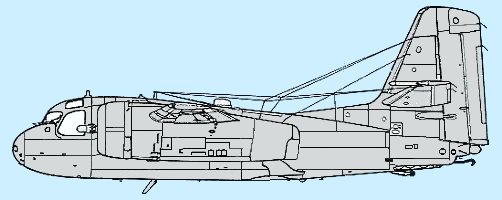 S-2B/S2F-1S
S-2B/S2F-1S
Only a few S-2As were modified with
newer ASW equipment and designated S-2Bs. The equipment was a JEZEBEL
acoustic search system and a JULIE acoustic echo ranging system. The
conversion process was stopped when a more advanced Tracker model became
available.
S-2F/S2F-1S1
The S-2F looked like the S-2A but was much more
advanced. The F had improved ASW electronics and newer JULIE acoustic echo
system. Lots of S-2Fs were used by the US Navy and a few were delivered to
other countries under the MDAP programme.
S-2C/S2F-2
In the 1950s the weapons bay of the Tracker turned
out to be to small for (large) nuclear depth charges. Grumman redesigned
the aircraft and gave it a weapons bay large enough for a nuclear bomb.
This was easy to recognize. The flying characteristics were improved by a
larger horizontal stabilizer. The engines and ASW equipment were retained.
A total of 60 were built.
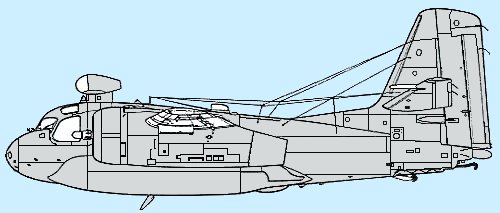
US-2C
After the first S-2Cs were replaced by newer models, a
large number of airframes were converted to transport aircraft. All ASW
equipment was removed but the sonobuoy installations in the engine
nacelles were retained.
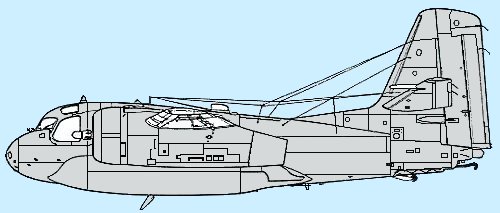 RS-2C/S2F-2P
RS-2C/S2F-2P
Only a single S-2C was modified to
carry out photo reconnaissance missions. The ASW equipment was removed and
six cameras were installed in various places in the underside of the
fuselage. The RS-2C was a good aircraft, but no more S-2Cs were modified.
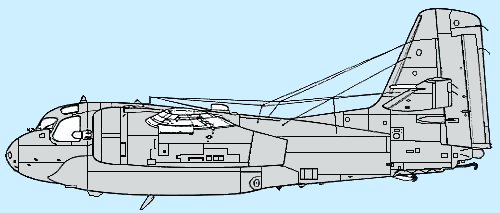 S-2D/S2F-3
S-2D/S2F-3
In the early 1960s the first of
100 factory fresh S2F-3s entered service with the US Navy. This
version showed many major changes. The radome on the forward fuselage was
gone and the engines were replaced by new R1820-82A engine with larger
intake on top. An enlarged weapons bay was no longer needed due to the
introduction of smaller nuclear depth charges. The forward fuselage for
extended 0.5 meter, making this Tracker more comfortable to the crew and
adding space for more fuel. The wing tips were rounded and fitted with ECM
equipment. The end of the engine nacelles was slightly redesigned to
increase the sonobuoy capacity. Not visible were the stronger weapons
pylons under the wings. All ASW equipment was modernized.
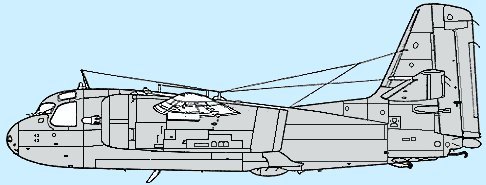
US-2D
A total of 54 S-2Ds were modified as transport and
training aircraft. The US-2D retained the radome in the belly of the
fuselage and the search light. All the ASW equipment however was removed.
The end of the engine nacelles were not closed.
ES-2D
An unknown version was the ES-2D, of which only 7 were
built for the Pacific Missile Ranges of the US Navy. They were former
S-2Ds mainly used for clearing the test areas of unauthorized persons
during missile launches. The ES-2D was also used as a AEW platform. Some
received an additional search radar under the forward part of the
fuselage.
S-2E/S2F-3S
The last new version of the Tracker built by
Grumman was the S-2E; later versions were all modified S-2s. There were
some external differences between the S-2D and S-2E. The E had a long
retractable antenna under the fuselage and an extra small radome behind
the belly search radar. Internally there were more changes. The tactical
navigation system was modernized and added with a computer. Improvements
in the MAD system doubled the detection range compared with the S-2A. A
total of 252 S-2Es were built, of which 238 entered service with
the US Navy.
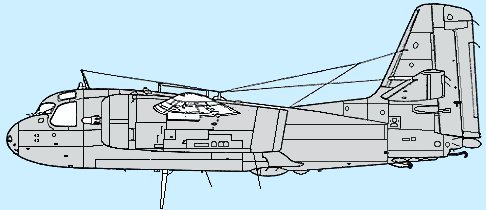
Specifications S-2E
| Length |
43 feet 6 inches |
|
| Maximum speed |
242 mph |
| Wingspan |
72 feet 7 inches |
|
| Range |
1000 miles |
| Height |
16 feet 7 inches |
|
| Service ceiling |
18,000 feet |
| Weight, empty |
19,033 pounds |
|
| Crew |
4 |
| Weight, maximum |
29,150 pounds
|
S-2G
The S-2G was the last version used by the US Navy. This
version look very much like the S-2E, but had an installation for smoke
markers on the starboard engine. The ASW equipment was updated further.
The modification from S-2E tot S-2G was carried out by the US Navy.
S-2T
Various companies offered to stretch the life of the
Tracker by installing turboprop engines. Until today only Argentina and
Taiwan have chosen for this option. Some civil users have modernized their
Tracker to Turbo Trackers, most of which are in use as firefighters.
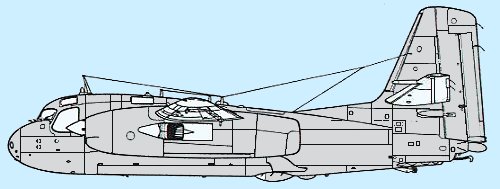
CS-2F-1
Canada was the only country that built its own
Trackers. DeHavilland in Toronto started building 44 CS2F-1s for
the Royal Canadian Navy in 1956. This version looked very much like the
S2F-1, but lacked the radome on the fuselage. This was replaced by a
considerable smaller antenna. In the wing tips, cylinder shaped ECM
antennas were applied.
CS-2F-2
DeHavilland soon received a second order for
55 CS2F-2s. This version looked almost identical to its forerunner.
The CS2F-2 had a better MAD system, more powerful radar and more sensitive
ASW sensors.
CS-2F-3
In the mid 1960s the Canadian Trackers were updated
in order to stretch their lives. This update involved a new tactical
navigation computer, a Doppler radar and more sensitive JULIE/JEZEBEL
sensors. In February 1968 the Trackers the designation CS2-F changed to
CP-121 and the Royal Canadian Navy became part of the Canadian Armed
forces.
| 






